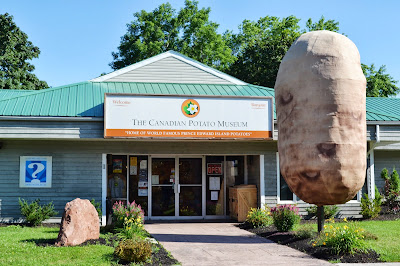After a 5 hour ferry ride we are back on land. Well it might
still be an island but it’s bigger. Leaving the ferry behind we headed south to
Brudenell River Provincial Park. It only took us 45 minutes. Very nice
campground, lots of trees and water and tons of mosquitoes.
 |
| Entrance to Brudenell River Provincial Park |
Our campsite had plenty of space with lots of trees making it very private. It included water, electric (50 amp), sewers, cable,
and even telephone connections. The site was badly sloped but we had no
trouble leveling with the 5th wheel. Of course the ground is red clay and when it rained what a mess.
 |
| Our site #24 |
 |
| Nice heated pool |
 |
| Horses available for trail riding |
 |
| Beautiful walking trails along beach |
Our first trip out of the campground found us in the
historic town of Georgetown. The buildings reflect the area’s history with at
least one third being 75 years or older. A focal point of Georgetown is the
Cenotaph AA Memorial Gardens.
 |
| Beautiful Gardens |
 |
| Largest steering wheel I've ever seen |
A parade was starting at 11 to commemorate Georgetown Days hence the reason for the mounted
police.
 |
| RCMP |
This church was the first in Georgetown, erected in 1839
when it was still a mission.
 |
| The church was in need of lots of TLC |
The court house was built in 1887 using the Island sandstone
giving it a reddish colour. The contrasting gray stone was brought over from
Nova Scotia. Originally the building was to face the opposite direction but the
builder got the plans reversed.
 |
| Courthouse |
The Macdonald House was built in 1835. All the lumber was
imported from Great Britain. It was once a bank with the original bank doors
still inside the building.
 |
| Macdonald House circa 1835 |
In 1732 Jean Pierre Roma established a settlement and
trading post enhancing the French presence on Prince Edward Island (Ile Saint
Jean). The site is called Roma at Three Rivers in Brudenell. Roma’s main
interest was to trade goods especially cod with New France, the West Indies,
and France. After 13 years and many hardships the venture ended in 1745 when
troops from New England destroyed the settlement after capturing Louisbourg.
Today there is no real evidence of the settlement except for a few cellar holes
and artifacts. From 1968 to 1970 an archaeological dig took place uncovering some
of Roma’s structures. Unfortunately due to lack of government funding the
project was abandoned and covered.
 |
| Replica of Roma's fortress |
 |
| Replica of the herb & flower gardens Roma would have had |
 |
| Bread Oven still used today |
 |
| Bread cooling rack |
The day would not be complete without uncovering a few
lighthouses.
 |
| Panmure Head Lighthouse |
As I have said to Susan numerous times you never know what
you will find when seeking out lighthouses. Point in case when we were looking
for Murray Harbour Lighthouse.
 |
| Murray Harbour Lighthouse |
The area is called Beach Point and is mostly used by the
locals. The tide was out making it very safe for young kids.
 |
| The beach was miles long |
 |
| Red sandy beach with red rocky cliffs |























































